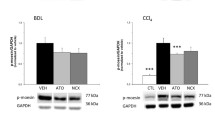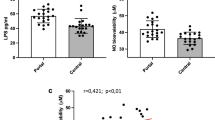Abstract
Increased endogenous nitric oxide production has been proposed as an important mediator of the peripheral arterial vasodilation and the hyperdynamic circulation in cirrhosis, whereas a decreased intrahepatic production of nitric oxide has been implicated in the pathogenesis of portal hypertension. The present study investigated the possible beneficial effects of methylene blue, which is a potent inhibitor of guanylate cyclase and nitric oxide synthase, on hyperdynamic circulation and renal function in cirrhotic patients with ascites together with the effects on portal hemodynamics. Twenty patients were evaluated at baseline and during 2 consecutive 4-hr periods after the administration of methylene blue at a dose of 3 mg/kg (10 patients) or placebo (10 patients). Mean arterial pressure, heart rate, cardiac output, systemic vascular resistance, plasma active renin, plasma aldosterone, plasma antidiuretic hormone, serum urea, serum creatinine, serum sodium, urinary flow rate, glomerular filtration rate, effective renal plasma flow, portal flow volume, and portal vein velocity were not modified by methylene blue or placebo. Urinary sodium excretion, fractional sodium excretion and serum nitric oxide levels were significantly decreased 4 hr after methylene blue administration (P < 0.05), to return toward basal levels over a further 4-hr period. It is concluded that methylene blue, at the dose used in the present study, has no effect on systemic and portal hemodynamics in cirrhotic patients with ascites. The reduction in renal sodium excretion, in the absence of changes in renal function and hemodynamics, suggests, at least partly, a direct antinatriuretic effect of methylene blue.
Similar content being viewed by others
References
Arroyo V, Colmenero J: Ascites and hepatorenal syndrome in cirrhosis: pathophysiological basis of therapy and current management. J Hepatol 38:S69–S89, 2003
Schrier R, Arroyo V, Bernardi M, Epstein M, Henriksen J, Rodes J: Peripheral arterial vasodilation hypothesis: a proposal for the initiation of renal sodium and water retention in cirrhosis. Hepatology 8:1151–1157, 1988
Vallance P, Moncada S: Hyperdynamic circulation in cirrhosis: a role for nitric oxide? Lancet 337:776–778, 1991
Martin PY, Gines P, Schrier RW: Nitric oxide as a mediator of hemodynamic abnormalities and sodium and water retention in cirrhosis. N Engl J Med 339:533–541, 1998
Genesca J, Gonzalez A, Segura R, Catalan R, Marti R, Varela E, Cadelina G, Martinez M, Lopez-Talavera JC, Esteban R, Groszmann RJ, Guardia J: Interleukin-6, nitric oxide, and the clinical and hemodynamic alterations of patients with liver cirrhosis. Am J Gastroenterol 94:169–177, 1999
Niedereberger M, Gines P, Tsai PY, Martin AW, Weigert K, Morris K, McMurtry YK, Schrier RW: Increased aortic cyclic guanosine monophosphate concentration in experimental cirrhosis in rats: evidence for a role of nitric oxide in the pathogenesis of arterial vasodilation in cirrhosis. Hepatology 21:1625–1631, 1995
Shah V, Haddad FG, Garcia-Gardena G, Frangos GA, Mennone A, Groszmann RJ, Sessa WC: Liver sinusoidal endothelial cells are responsible for nitric oxide modulation of resistance in the hepatic sinusoids. J Clin Invest 100:2923–2930, 1997
Rockey DC, Chung JJ: Reduced nitric oxide production by endothelial cells in cirrhotic rat liver: endothelial dysfunction in portal hypertension. Gastroenterology 114:344–351, 1998
Marczin N, Ryan US, Catravas JD: Methylene blue inhibits nitrovasodilator and endothelium-derived relaxing factor-induced cyclic GMP accumulation in cultured pulmonary arterial smooth muscle cells via generation of superoxide anion. J Pharmacol Exp Ther 263:170–179, 1992
Mayer B, Brunner F, Schmidt K: Inhibition of nitric oxide synthesis by methylene blue. Biochem Pharmacol 45:367–374, 1993
Schenk P, Madl C, Rejaie–Majd S, Lehr S, Muller C: Methylene blue improves the hepatopulmonary syndrome. Ann Intern Med 13:701–706, 2000
McGinn PV: Reversal of the haemodynamic features of acute liver failure by methylene blue. Intensive Care Med 22:612, 1996
Arroyo V, Gines P, Gerbes AL, Dudley FJ, Gentilini P, Laffi G, Reynolds TB, Ring-Larsen H, Scholmerich J: Definition and diagnostic criteria of refractory ascites and hepatorenal syndrome in cirrhosis. Hepatology 23:164–176, 1996
Midgley S, Grant IS, Haynes WG, Webb DJ: Nitric oxide in liver failure. Lancet 338:1590, 1991
Rolla G, Bucca C, Brussino L: Methylene blue in the hepatopulmonary syndrome. N Engl J Med 331:1098, 1994
Blaufox MD: Measurement of renal function with radioactive materials. In Evaluation of Renal Funcation and Disease with Radionuclides. The Upper Urinary Tract. Blaufox MD (ed). Basel, Karger, 1989, pp 12–27
Clifton J, Leikin JB: Methylene blue. Am J Ther 10:289–291, 2003
Petros A, Bennet D, Vallance P: Effect of nitric oxide synthase inhibitors on hypotension in patients with septic shock. Lancet 338:1557–1558, 1991
Preiser JC, Lejeune P, Roman A, Carlier E, De Backer D, Leeman M, Kahn RJ, Vincent JL: Methylene blue administration in septic shock: a clinical trial. Crit Care Med 23:259–264, 1995
Zhang H, Rogiers P, Preiser JC, Spapen H, Manikis P, Metz G, Vincent JL: Effects of methylene blue on oxygen availability and regional blood flow during endotoxic shock. Crit Care Med 23:1711–1721, 1995
Gachot B, Bedos JP, Veber B, Wolff M, Regnier B: Short-term effects of methylene blue on hemodynamics and gas exchange in humans with septic shock. Intensive Care Med 21:1027–1031, 1995
Bech JN, Mielsen CB, Pedersen EB: Effects of systemic NO synthesis inhibition on RPF, GFR, UNa, and vasoactive hormones in healthy humans. Am J Physiol 270:845–851, 1996
Thiesson HC, Skøtt O, Jespersen B, Schafflitzky de Muckadell OB: Nitric oxide synthase inhibition does not improve renal function in cirrhotic patients with ascites. Am J Gastroenterol 98:180–186, 2003
La Villa G, Barletta G, Pantaleo P, Del Bene R, Vizzutti F, Vecchiarino S, Masini E, Perfetto F, Tarquini R, Gentilini P, Laffi G: Hemodynamic, renal, and endocrine effects of acute inhibition of nitric oxide synthase in decompensated cirrhosis. Hepatology 34:19–27, 2001
Levey AS, Madaio MP, Perrone RD: Laboratory assessment of renal disease: clearance, urinalysis, and renal biopsy. In The Kidney, 4th ed. Brenner BM, Rector FC Jr (eds). Philadelphia, Saunders, 1991, pp 919–968
Dijkhorst-Oei LT, Koomans HA: Effects of a nitric oxide inhibitor on renal sodium handling and diluting capacity in humans. Nephrol Dial Transplant 13:587–593, 1998
Tost H, Hably C, Lengyel M, Gogl A, Lendvai A, Bartha J: Effect of nitric oxide synthase inhibition on renal circulation and excretory function in anaesthetized rats. Exp Physiol 85:791–800, 2000
Cases A, Haas J, Burnett JC, Romero JC: Hemodynamic and renal effects of acute and progressive nitric oxide synthesis inhibition in anesthetized dogs. Am J Physiol Regul Integr Comp Physiol 280:143–148, 2001
Claria J, Jimenez W, Ros J, Asbert M, Castro A, Arroyo V, Rivera F, Rodes J: Pathogenesis of arterial hypotension in cirrhotic rats with ascites: role of endogenous nitric oxide. Hepatology 15:343–349, 1992
Arroyo V, Jimenez W: Complications of cirrhosis. II. Renal and circulatory dysfunction. Lights and shadows in an important clinical problem. J Hepatol 32(Suppl 1):157–170, 2000
Bachmann S, Mundel P: Nitric oxide in the kidney: synthesis, localization, and function. Am J Kidney Dis 24:112–129, 1994
Andersen JL, Sandgaard NC, Bie P: Volume expansion during acute angiotensin II receptor (AT (1)) and NOS inhibition in conscious dogs. Am J Physiol Regul Integr Comp Physiol 282:1140–1148, 2002
Iwao T, Toyonaga A, Oho K, Tayama C, Masumoto H, Sakai T, Sato M, Tanikawa K: Value of Doppler ultrasound parameters of portal vein and hepatic artery in the diagnosis of cirrhosis and portal hypertension. Am J Gastroenterol 26:305–311, 1997
Pizcueta P, Pique JM, Fernandez M, Bosch J, Rodes J, Whittle BJ, Moncada S: Modulation of the hyperdynamic circulation of cirrhotic rats by nitric oxide inhibition. Gastroenterology 103:1909–1915, 1992
Pilette C, Moreau R, Sogni P, Kirstetter P, Cailmail S, Pussard E, Lebrec D: Haemodynamic and hormonal responses to long-term inhibition of nitric oxide synthesis in rats with portal hypertension. Eur J Pharmacol 312:63–68, 1996
Forrest EH, Jones AL, Dillon JF, Walker J, Hayes PC: The effect of nitric oxide synthase inhibition on portal pressure and azygos blood flow in patients with cirrhosis. J Hepatol 23:254–258, 1995
Author information
Authors and Affiliations
Corresponding author
Rights and permissions
About this article
Cite this article
Kalambokis, G., Economou, M., Fotopoulos, A. et al. Effects of Nitric Oxide Inhibition by Methylene Blue in Cirrhotic Patients with Ascites. Dig Dis Sci 50, 1771–1777 (2005). https://doi.org/10.1007/s10620-005-2935-8
Received:
Accepted:
Issue Date:
DOI: https://doi.org/10.1007/s10620-005-2935-8




